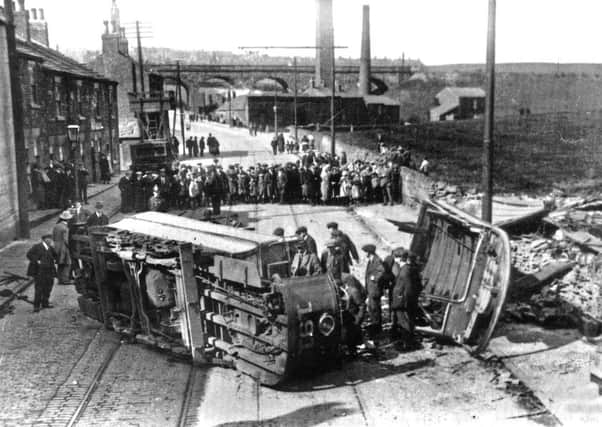Nostalgia on Tuesday. Terror on trams


Many Yorkshire cities and towns followed the pattern of tramway developments across the UK.
Initially, vehicles were pulled along rails by horses, progressing to steam locomotives and finally, around the dawn of the 20th century, electric trams, collecting power from overhead lines, were widely adopted.
Advertisement
Hide AdAdvertisement
Hide AdTramways enabled Yorkshire local authorities to get to grips with public transport when the region as a whole saw massive developments in the steel, coal and woollen industries.
Naturally, this new form of transport had its pitfalls and there were a number of noted tram accidents and collisions especially in the hilly districts of the county. Accidents occurred for a number of reasons including staff errors, bad weather and faulty brakes.
Many Yorkshire tram crashes in the first decades of the 20th Century became a ghoulish subject for postcard photographers to record. Arguably, the most remarkable features of these early postcards are the expressions on the faces of those gathered round the crashed tram – all eager to show their horror of the incident, but all wanting to be included in the picture nonetheless.
Several staff errors resulted in a tram crash in Sheffield on March 27, 1902. A single-deck car was standing at the Intake terminus during the afternoon of that day when the conductor, thinking he had heard the bell to move off released the handbrake. The driver was not in his place and the tram ran down a hill, on one of the steepest routes on the system, towards the city. The passengers were terrified, but powerless as it left the rails and crashed into a wall. Fortunately, only two of the passengers sustained injuries and they were not serious. Both the driver and conductor were subsequently dismissed.
Advertisement
Hide AdAdvertisement
Hide AdOwing to the greasy state of the tram rails in Dewsbury on Tuesday afternoon October 12, 1915, tram driver, John Callaghan lost control of his vehicle about 100 yards from the terminus. This was the third accident that had occurred in the same locality. Car no. 3 running between Dewsbury, Ossett and Earlsheaton left the metals in front of Dewsbury Town Hall and crashed into Hilton’s shop adjoining the Scarborough Hotel. Tuesday afternoon was a half-day for Dewsbury traders and their assistants and luckily the premises were empty. Driver Callaghan jumped off the car 10 yards before it hit the building. The conductress, Maggie Sadler also tried to escape, but both were injured. The front portion of the tram smashed through the wall of the shop. A Mrs Parker and her daughter, Mrs Noble, were injured by a horse and cart getting out of the way of the tram. All four people were taken to Dewsbury District Infirmary. An hour after the crash, a first floor room collapsed and fell on to the tram and into the market place.
Heavy rainstorms, accompanied by a fierce wind, blew in violent gusts on Friday December 3, 1920. Three people were very fortunate to escape with only slight injuries in a tramway accident on the Halifax system. During Friday afternoon, two double-decker cars, nos 98 and 50, were blown over on the exposed Queensbury route at Catherine Slack. The first car which contained only three people, was hurled over and the second car, which was empty, met a similar fate almost at the same place, two or three hours later.
The amazing part of the extraordinary accident at Scarborough on Wednesday September 10, 1923 was that no one was killed. Double-decked Scarborough tram no. 21 ran backwards down Vernon Place, crashed through a stone wall bordering the top of the Aquarium and plunged through the glass roof of the building falling, end on, into the ballroom 30ft below. Only three people were slightly injured – the driver of the car, George Darley Smith – who courageously stuck to his post and was found among the wreckage – and two visitors from Pudsey, Police Constable Robinson and his wife. Mr and Mrs Robinson, jumped off, falling into the roadway. The cause of the accident was attributed to the tram losing its grip on a problematic section of track near the top of the incline.
Bad maintenance and staff errors contributed to the accident in Leeds on May 12, 1923, where seven people were killed and 44 injured. The tragedy occurred on the Morley route of the Leeds Tramways at about 7am. A workman’s tramcar (no 191) from Morley to Leeds ran away down Churwell Hill and, at speed, jumped the rails at the bottom, dashed into a wall and overturned in the road. It was carrying about 50 people. Many of the passengers were women and girls.
Advertisement
Hide AdAdvertisement
Hide AdOne of the steepest gradients on the tramway system connecting Rotherham with Mexborough, South Yorkshire was at Warren Hill, Swinton (between Rawmarsh and Kilnhurst). On Thursday morning July 30, 1908 car no. 14, filled with colliers on their way to work, went out of control due to a brake failure, It demolished a wall, and dropped into a garden 10ft below. One man who jumped from the car had a broken collar bone. Others were bruised and cut by broken glass.
Sheffield is the only Yorkshire city to introduce trams once more and there have been several incidents. A motor vehicle was overturned in a collision with a tram at Manor Top during February 1997 and another incident was recorded at the junction of Infirmary Road and Terrace Road, Shalesmoor, on April 10,1999.